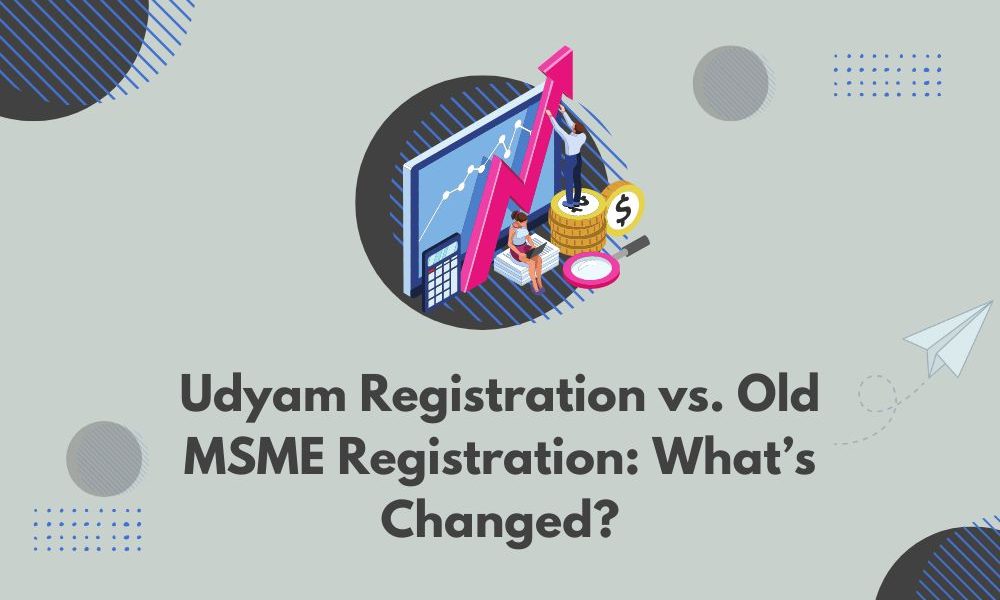Micro, Small, and Medium Enterprises (MSMEs) play a vital role in the economic development of any country. In India, MSMEs are a significant contributor to GDP, exports, and employment. To support and regulate these enterprises, the government has introduced various registration processes. The most recent change in this domain is the introduction of Udyam Registration, replacing the old MSME registration process. This blog will explore the differences between Udyam Registration and the old MSME registration, highlighting what’s changed and how it impacts business owners.
Understanding MSME Registration
The Old MSME Registration Process
Previously, MSME registration was done under the Micro, Small, and Medium Enterprises Development (MSMED) Act, 2006. The process involved obtaining an MSME certificate, which was also known as Udyog Aadhaar. Here’s a breakdown of the old registration process:
-
Udyog Aadhaar Memorandum (UAM):
- The Udyog Aadhaar Memorandum was a one-page form that business owners had to fill out.
- It required basic details like Aadhaar number, business name, address, bank details, and the type of business activity.
-
Categorization:
- MSMEs were categorized based on investment in plant and machinery or equipment.
- Micro Enterprises: Investment up to ₹25 lakhs (manufacturing) or ₹10 lakhs (services).
- Small Enterprises: Investment between ₹25 lakhs to ₹5 crores (manufacturing) or ₹10 lakhs to ₹2 crores (services).
- Medium Enterprises: Investment between ₹5 crores to ₹10 crores (manufacturing) or ₹2 crores to ₹5 crores (services).
-
Certificate Issuance:
- Upon submission of the form, an MSME certificate was issued, which could be used to avail various government schemes and benefits.
Also read:- Update Udyam Certificate Online
Limitations of the Old MSME Registration
The old MSME registration process had several limitations:
- Complexity: The process was often seen as cumbersome and time-consuming.
- Lack of Standardization: There were inconsistencies in how MSMEs were categorized and registered across different states.
- Manual Intervention: The need for manual verification and intervention led to delays and errors.
Introduction to Udyam Registration
In 2020, the Indian government introduced Udyam Registration to simplify and streamline the process for MSMEs. This new system aimed to address the shortcomings of the old registration method and make it easier for businesses to register and avail benefits.
Key Features of Udyam Registration
-
Online Registration:
- The entire registration process is now online, eliminating the need for physical paperwork.
- Business owners can register through the official Udyam Registration portal.
-
Simplified Criteria:
- The criteria for categorizing MSMEs have been simplified.
- The new criteria are based on both investment and turnover.
- Micro Enterprises: Investment up to ₹1 crore and turnover up to ₹5 crores.
- Small Enterprises: Investment up to ₹10 crores and turnover up to ₹50 crores.
- Medium Enterprises: Investment up to ₹50 crores and turnover up to ₹250 crores.
-
Automatic Data Integration:
- The Udyam Registration portal is integrated with the Income Tax and GST systems.
- This integration allows automatic verification of business details, reducing the need for manual intervention.
-
Ease of Updating Information:
- Business owners can easily update their information on the Udyam portal.
- Changes in investment, turnover, or business details can be updated without hassle.
-
Self-Declaration:
- The registration process relies on self-declaration by the business owner.
- There is no requirement for uploading documents or certificates during the registration.
Benefits of Udyam Registration
Udyam Registration offers several advantages over the old MSME registration process:
Simplified Process
- User-Friendly Interface: The Udyam Registration portal is designed to be user-friendly, making it easy for business owners to navigate and complete the registration.
- Reduced Paperwork: The online process significantly reduces the paperwork involved, saving time and effort.
Faster Registration
- Quick Verification: Integration with the Income Tax and GST databases ensures quick verification of business details.
- Immediate Issuance: Once the details are verified, the Udyam certificate is issued immediately.
Enhanced Credibility
- Government Recognition: Udyam Registration provides official recognition from the government, enhancing the credibility of the business.
- Access to Benefits: Registered businesses can easily access various government schemes, subsidies, and financial assistance.
Transitioning from Old MSME Registration to Udyam Registration
Steps to Transition
If you have an existing MSME registration, you need to transition to Udyam Registration. Here’s how you can do it:
-
Visit the Udyam Registration Portal:
- Go to the official Udyam Registration portal (https://udyam-registrations.org/).
-
Enter Existing Registration Details:
- Provide your existing Udyog Aadhaar Number (UAM) and other necessary details.
-
Verify Information:
- Verify the information provided and ensure it is accurate.
-
Complete Registration:
- Complete the Udyam Registration process by filling out any additional required information.
- Submit the form and obtain your Udyam certificate.
Important Considerations
- Deadline for Transition: It is important to note the deadline set by the government for transitioning to Udyam Registration. Ensure you complete the process within the stipulated time to avoid any disruptions in availing benefits.
- Verification of Details: Double-check all the details before submission to ensure accuracy and avoid any issues during verification.
Key Differences Between Udyam Registration and Old MSME Registration
Criteria for Classification
- Old MSME Registration: Classification was based solely on investment in plant and machinery or equipment.
- Udyam Registration: Classification is based on both investment and turnover, providing a more comprehensive assessment of the business.
Registration Process
- Old MSME Registration: The process was largely manual, requiring physical paperwork and manual verification.
- Udyam Registration: The process is entirely online, with automatic data integration and self-declaration.
Verification and Issuance
- Old MSME Registration: Manual intervention often led to delays in verification and certificate issuance.
- Udyam Registration: Integration with government databases ensures quick verification and immediate issuance of the certificate.
Conclusion
Udyam Registration marks a significant improvement over the old MSME registration process. It simplifies the registration process, reduces paperwork, and provides quicker verification and certificate issuance. The new criteria based on investment and turnover offer a more accurate classification of businesses, ensuring they receive the appropriate benefits and support. If you are a business owner with an existing MSME registration, transitioning to Udyam Registration is essential to continue availing government benefits and schemes. The process is straightforward and can be completed online, making it easier than ever to register your business and enhance its credibility.





